29+ Sample Family Assessments
-

Family Assessment Genogram Template
download now -
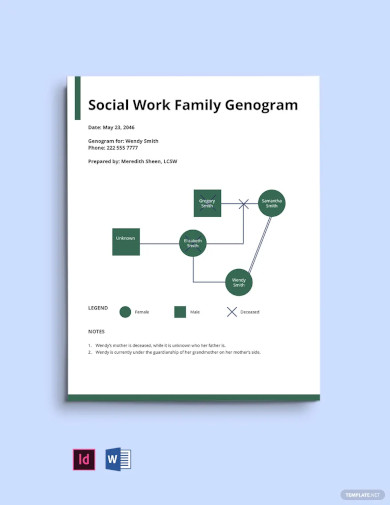
Free Social Work Family Assessment Genogram Template
download now -
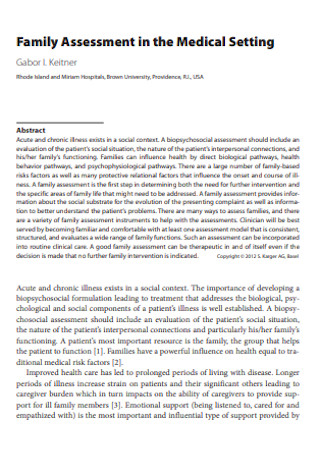
Family Assessment in Medical Setting
download now -
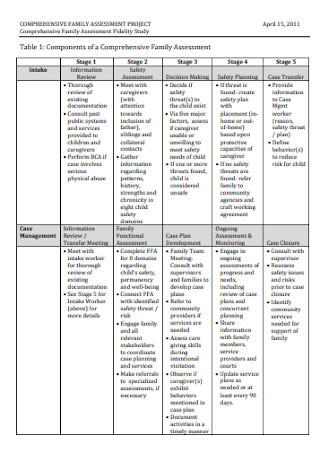
Comprehensive Family Assessment
download now -
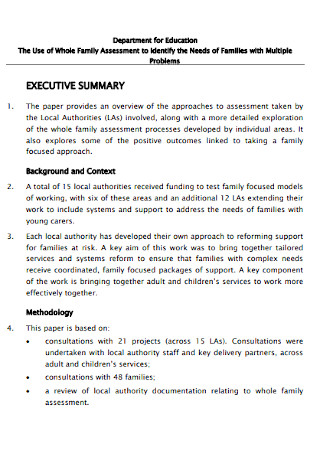
Whole Family Assessment
download now -
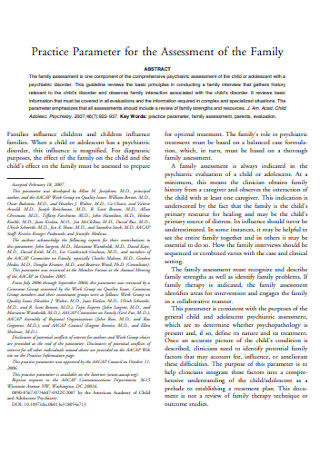
Parameter for the Assessment of the Family
download now -
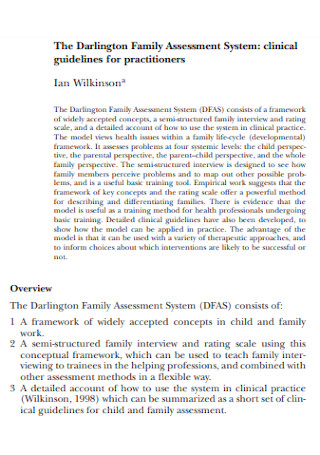
Family Clinic Assessment
download now -
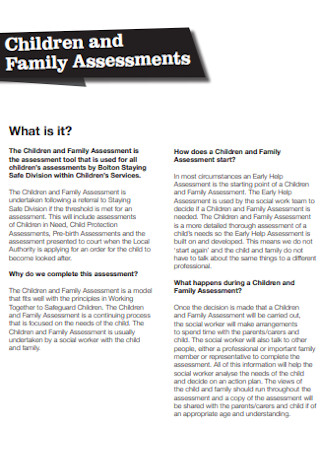
Children and Family Assessments
download now -
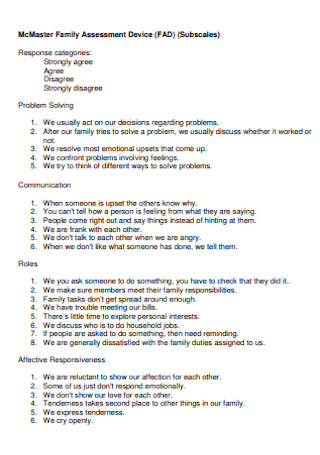
Master Family Assessment
download now -
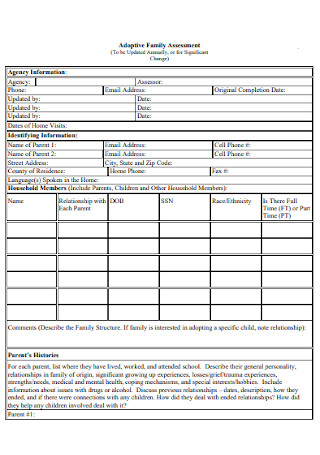
Adoptive Family Assessment
download now -
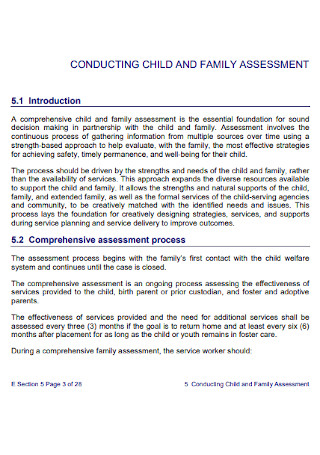
Child and Family Assessment
download now -
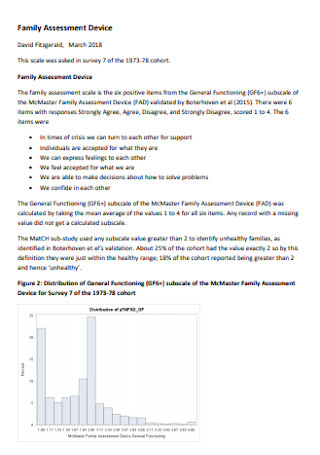
Family Assessment Device Template
download now -
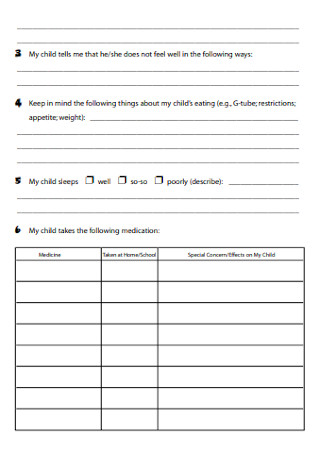
Family Assessment of Children
download now -

Family Assessment Analysis
download now -
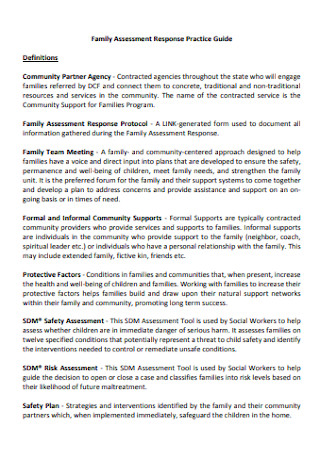
Family Assessment Format
download now -
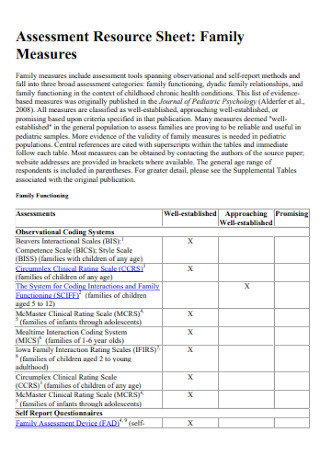
Family Assessment Resource Sheet
download now -
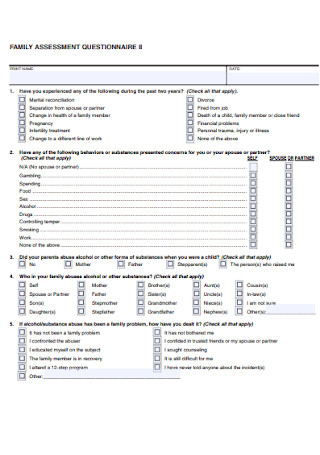
Family Assessment Questionnaire
download now -
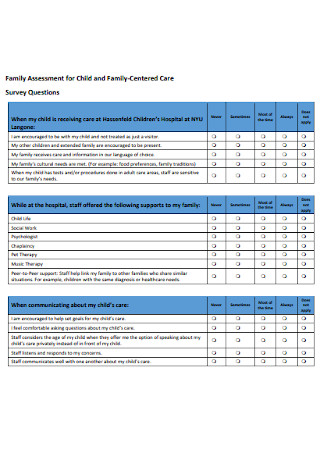
Family Assessment for Child
download now -
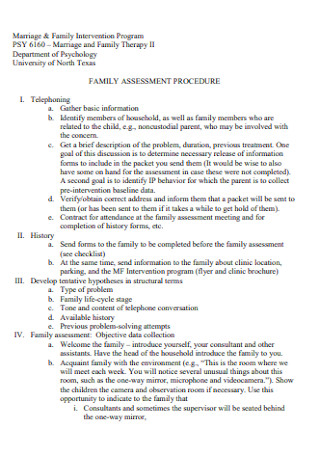
Marriage and Family Assessment
download now -
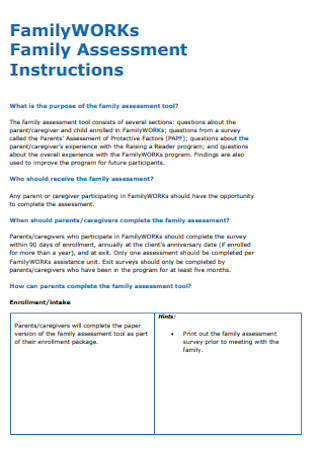
Family Work Assessment
download now -
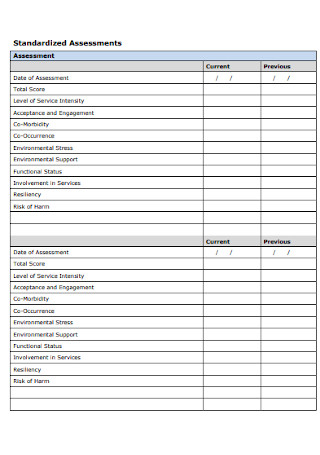
Individual Family Assessment
download now -
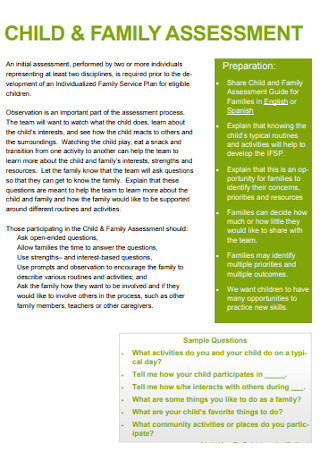
Child and Family Assessment Template
download now -
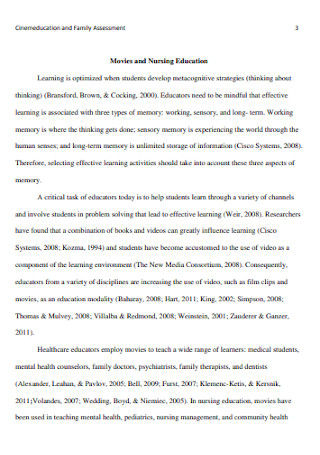
Cinemeducation and Family Assessment 3
download now -
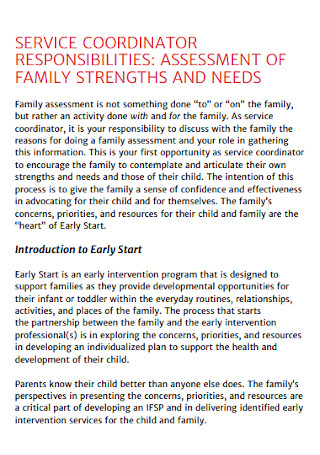
Assessment of Family Strengths
download now -
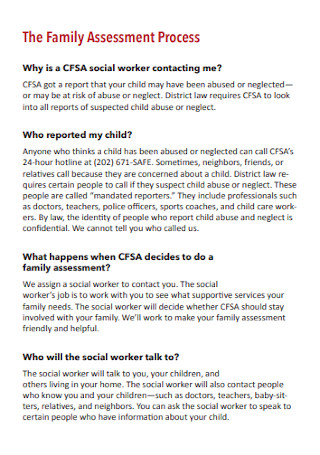
Sample Family Assessment
download now -
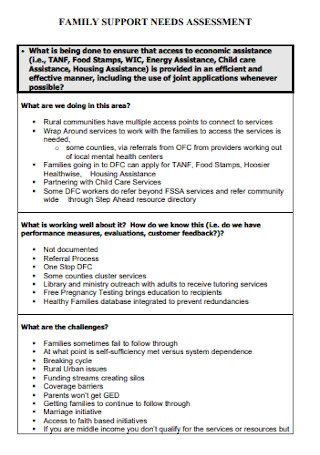
Family Support Needs Assessment
download now -

Sessional Family Assessment Workers
download now -
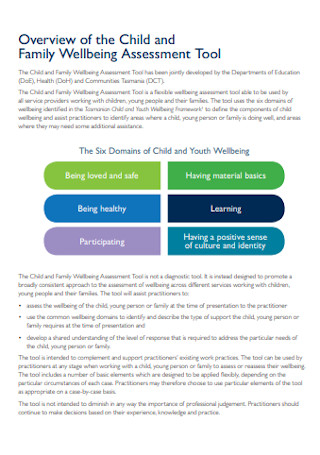
Family Wellbeing Assessment
download now -
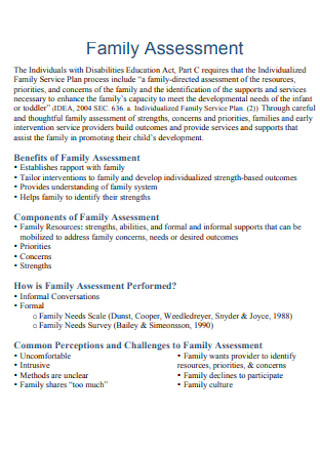
Simple Family Assessment
download now -
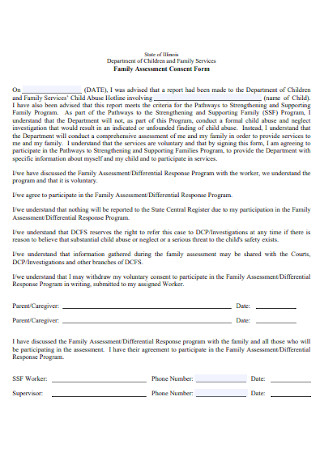
Family Assessment Consent Form
download now
FREE Family Assessment s to Download
29+ Sample Family Assessments
What is a Family Assessment?
Different Types of Family Assessments
Benefits of Using a Family Assessment
Basic Features of a Family Assessment
How to Write a Family Assessment
FAQs
What are some examples of family assessments?
What is the purpose of family assessment?
What are the essential steps in developing a family assessment?
What is the difference
What is a Family Assessment?
A family assessment is a simple and structured document that outlines multi-dimensional approaches, tools, and methods in motivating families to start assessment work and facilitate family interaction. It is beneficial in observing and analyzing the dynamics of the entire family, as well as the relationships between family members, provisioning a model in terms of understanding, describing and assessing family strengths, challenges and competencies. Also, it is specifically valuable to more complex families.
According to a 2019 annual report published by National Center for Education Statistics, about 9% of children under the age of 18 lived in households in which no parent had completed high school, 26% lived in mother-only households, 8% lived in father-only households, and 16% were in families living in poverty. Thus, family counselors, caregivers, and parents should have a definite goal of thoroughly assessing and accurately diagnosing factors, risks, adversities, strengths, and competencies through an effective and systematic family assessment. By doing this, it will fully utilize resources in managing risk and adversities in order to facilitate and reinforce optimal functioning and improvement.
Different Types of Family Assessments
Family Assessment Handbook: An Introductory Practice Guide to Family Assessment stated that there are many models of family practice as many practitioners prefer to approach families with the concept of determining interventions in order to improve individual and family functioning. Also, the commonalities across models such as building strong therapeutic relationships, assisting families search at their problems differently, applying evidence-based interventions, and engaging families in collaborative problem solving are the basic mechanisms of transformation. In this section, you will know and understand more about the different types of family assessments:
1. Family Assessment in a Medical Setting
Based on a research paper, families can influence health through direct biological pathways, health behavior pathways, and psychophysiological pathways. So, in order to identify both the necessity for additional intervention and the target areas of family life that might need to be resolved, it is crucial to create a family assessment in a medical setting. Also known as biopsychosocial assessment, it demonstrates a thorough evaluation of the social condition, interpersonal connections, and the family functioning of the patient. This type of family assessment can be incorporated into routine clinical care which can be therapeutic for the patient.
2. Adoptive Family Assessment
When a married couple successfully adopts a child, it is important to determine the existing state of parent-child adjustment of post-adoption of the married couple that have adopted children. So, it is important to use adoptive family assessment. The new adoptive parents will be asked to answer demographic questions, a Strength and Difficulty Questionnaire, a Parental Stress Scale Questionnaire, and questions concerning the services through a phone or online interview. A 2018 study shows that approximately 25% of the participants stated there was no follow up after the adoption was finalized, and only 50% were informed of the services that were available to them.
3. Family Work Assessment
Family work involves child care, cleaning, feeding, educating, and assisting children to other school events and appointments. Overcoming the family-work balance conflict inside young growing families can be stressful for the members of the family. Some families have one parent who works as a stay-home parent who is in-charge of the duties of the home and child care while the other parent works outside the home to support the family’s finances. However, many families nowadays have dual-income family style as both parents work outside the home. So, developing an effective family work assessment is essential in order to review the family-work balance of a certain family.
4. Assessment of Family Strengths
Sharing feelings, humor, faithfulness, dependability, respect for individuality, playfulness and quality time in great quantity are some examples of family strengths which are notable qualities that contribute to elevating the emotional health and well-being of the family. To further enhance the relationships in the family, it is essential to use an assessment of family strengths. This will be useful in bringing family members closer together, especially when challenging times suddenly happen. We suggest that you try using a Family Life Inventory Activity that could be accomplished when family members could finish the inventory individually while comparing perceptions, or the family could participate together in coming up with a group rating on each quality. Then, allow each member to join in pinpointing where the problem spots are and what has caused them. After that, create an action plan to develop the family’s unrealized potential.
5. Family Support Needs Assessment
A statistical report shows that there were 51,510 children in need of child protection plans, a decrease of 1.4% from the same point in 2019. If there is a family in crisis or if the members of the family are unable to meet their basic needs, it is crucial to use a family support needs assessment. Some examples of family support are counseling services, medicare, employment and skills training, and special family support services. Specializing in areas such as domestic violence or child protective services, a family support specialist can evaluate the needs of the family and provide them referrals for educational and support programs through using a family support needs assessment.
Benefits of Using a Family Assessment
Oscar Wilde said: “The best way to make children good is to make them happy.” Children who have good behaviour tend to gain true happiness in the family while others who feel neglected, misunderstood, or under intense pressure can simply act out their happiness. A family assessment can be a valuable tool in assessing children as well. What are the notable benefits of using a simple and cohesive family assessment? Below are some of the primary benefits of using a family assessment:
1. Support Family Members
Using a family assessment can be helpful in supporting family members. The book Family Support: Prevention, Early Intervention and Early Help explained that family assessment can prevent the emergence or worsening of family issues, assist children and young people in developing their skills and resilience, and aim for desirable change. Thus, various approaches in family assessment can maximize household resources, improve the well-being and life chances of children, etc.
2. Pinpoint Strengths and Weaknesses
Through conducting family assessment, a family counselor, professional therapist or family support specialist can pinpoint the specific strengths and weaknesses of each member in the family. Upon knowing these crucial factors, he or she can maintain and assess the potential further growth and development of the entire family.
3. Establish a Stronger Family Culture
Jim Taylor said: “A family-value culture that your children are raised in precedes the presence of popular culture and can fill the need for a culture in your children’s lives.” Establishing a stronger family culture through family assessment is wholesome for the children, teens, and young adults in the family as they will prefer to accomplish the right thing without any strong demands coming from the parents. So, set up solid and meaningful values, behaviors, and beliefs to promote stronger family culture.
Basic Features of a Family Assessment
In this section, you will learn how to construct a remarkably written and well-designed family assessment. However, a family assessment report has different features. Include the following elements for you to create an impressive document:
How to Write a Family Assessment
What are the relative strengths and weaknesses of the family? Are there safety and protection issues that need to be addressed? Can the family meet the needs of the child? Is the family competent to provide for basic needs? When conducting an interview for family assessments, it is important to answer these questions. Below are some easy-to-follow tips that indicate how to design and create a professional family assessment report:
Step 1: Conduct a Research
Look for essential information about the family that will be assessed. You might also obtain necessary information from the Child Welfare Information Gateway if there exists an abuse neglect case which involves youth inside the family. So, conduct a research and background check about the family. Then, organize the data on a preliminary family assessment form.
Step 2: Observe and Evaluate the Structure of the Family
Talk with the family so that you are able to observe and understand the overall structure of the family. For example, the parents, aunts, grandparents and cousins who are currently living with the family. Then, identify certain family members who should be involved in the evaluation.
Step 3: Analyze and Measure Development Cycles in the Family
Analyze the family life cycle so that you are able to fully comprehend how the family has reached through each phase in their development through the assessment. For example, a married couple becoming new parents could have triggered some problems in the family. Knowing this aspect can help you and your team to formulate strategic solutions to help the family.
Step 4: Ponder the Relationships in the Family
Meet up with the members of the family and allow each member to express their ideas, concerns, emotions, and feelings towards each other as well as their family values in a harmonious way. Know how the siblings communicate with one another, and see the parent-child relationships, especially how each one of them supports each other. It is crucial to see the family interactions so that each of them can overcome the challenges in life and how they can work together as one.
Step 5: Use Specialized Assessments If Necessary
Abuse or neglect concerns, cognitive concerns, domestic violence concerns, substance abuse issues, and youth behavioral problems are some examples of specialized assessments that you can do to determine possible problems that affect a family member if necessary.
Step 6: Develop an action plan
The final step is to develop a systematic action plan in supporting the needs and desired outcomes of the family. It should consist of fundamental points that family and your team that should be addressed such as setting up a support system, ensuring child safety and many others. This plan is beneficial to execute right away so that you and your team can work with the family, along with other therapies and support systems.
FAQs
Some examples of family assessments are family assessment in medical setting, adoptive family assessment, family assessment analysis, family assessment questionnaire, family work assessment, assessment of family strengths, family support needs assessment, family wellbeing assessment, and more.
What are some examples of family assessments?
The purpose of a performance report is to assist families establish a stronger family culture, especially in helping them to overcome major challenges and difficulties through the support of professional family counselors and therapists. Also, it is useful for families without major problems as it enhances familial relationships through improved communication and education.
What is the purpose of family assessment?
Search for any fundamental information provided about the family and organize the details you have on a preliminary family assessment form. Observe and evaluate the structure of the family and identify the family member who should be in the evaluation process and the specific plan of action to apply. Then, measure the development cycles inside the family. After that, meet up with the family members and let them express their honest feelings concerning their familial relationships and family values. Next, determine the specialized assessments which are typically individualized to indicate possible issues that affect a family member. Lastly, create a clear and structured plan of action.
What are the essential steps in developing a family assessment?
A family assessment is a method which has been undertaken by social scientists, family counselors, therapists, and other practitioners in examining a wide array of dimensions of family life. On the other hand, an individual assessment is a comprehensive evaluation of a person concerning his or her skills, abilities, behaviours, feelings, emotions, etc.
What is the difference between a family assessment and an individual assessment?
Christina Rossetti said: “For there is no friend like a sister in calm or stormy weather; to cheer one on the tedious way, to fetch one if one goes astray, to lift one if one totters down, to strengthen while one stands.” Indeed, families empower meaningful connections for each one of us, giving us a sense of identity and belonging. Therefore, writing a clear and well-detailed family assessment is a beneficial way in fully understanding and appreciating the way that families experience and manage their life stressors. So, here are some of our downloadable and printable family assessment report samples available in different kinds of formats. Simply click the family assessment report templates in this article and start downloading now!
